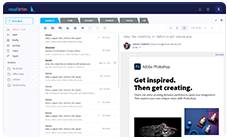The Power of Email Management Software for Modern Teams
- 2 months ago
- By Rishika Kuna

Email remains the lifeline of modern business communication. Whether you’re coordinating with clients, sharing updates across departments, or handling customer support, email continues to play a crucial role in daily operations.
However, as inboxes overflow and teams scale, manual handling of emails can quickly turn into chaos. Employees spend hours sorting, replying, and following up—time that could be better spent on productive work.
This is where email management software steps in. By automating, organizing, and streamlining communication, it empowers teams to collaborate more effectively and maintain focus on meaningful tasks.
What Is Email Management Software?
Email Management Software is a generation answer that allows people and companies to efficiently arrange, prioritise, and handle electronic mail communication. Instead of manually sorting through endless inboxes, this software program automates repetitive responsibilities along with filtering, tagging, routing, and archiving emails.
It acts as a centralised platform that brings shape and visibility to your communication, allowing companies to collaborate greater efficaciously. Whether you’re handling client inquiries, internal requests, or mission updates, email management equipment makes sure that every message is tracked, assigned, and resolved right away.
Core Capabilities Include:
- Centralized Inbox: View and manage more than one debt from a unmarried dashboard.
- Automated Sorting: Filter, categorize, and prioritize emails the usage of hints.
- Collaboration Tools: Assign emails to crew individuals and song responses.
- Analytics and Reports: Measure reaction times, workloads, and crew efficiency.
- Security and Compliance: Encrypt sensitive records and ensure email retention rules.
Why Businesses Need Email Management Software
1. Boosts Productivity and Efficiency
Without automation, employees spend a mean of 3 hours each day dealing with emails. An electronic mail control software program automates repetitive obligations, consisting of sorting, tagging, and responding to recurring queries—saving countless hours.
Benefits consist of:
- Reduced time spent on manual sorting
- Faster reaction to vital messages
- Streamlined inner verbal exchange
- Focus on the center business company sports rather than the inbox muddle
2. Enhances Team Collaboration
Modern corporations thrive on transparency and short get right of entry to to statistics. Shared inboxes, internal electronic mail manage equipment, permit more than one customer to view, respond to, and control the same mailbox collaboratively.
Team collaboration blessings:
- Assign emails to specific group individuals
- Use inner notes to speak about purchaser queries
- Prevent duplicate responses
- Track accountability and workflow development
3. Improves Communication Flow
Emails are often scattered throughout more than one folder, creating silos of data. A unified email management platform ensures every message is seen and traceable, assisting higher decision-making.
Improved communication ends in:
- Consistent messaging across departments
- Clear audit trails of all email conversations
- Seamless handover amongst personnel
4. Strengthens Data Security and Compliance
In industries dealing with touchy information—finance, healthcare, or felony sectors—email compliance is non-negotiable.
Email control software program software guarantees regular garage, encryption, and retention of messages at the same time as adhering to policies that include GDPR and HIPAA.
Security-centered capabilities:
- Advanced junk mail and phishing filters
- Role-based provides proper access to control
- Encrypted e-mail transmission
- Automated archiving for compliance and audits
5. Reduces Operational Costs
Manually maintaining email structures or a couple of disconnected devices results in inefficiencies and hidden expenses. A unified solution minimizes IT overhead by consolidating communications, lowering software redundancy, and eliminating manual tasks.
How monetary savings arise:
- Less dependency on manual tracking
- Reduced the need for a couple of licenses
- Fewer productivity losses because of non-time communication
6. Provides Actionable Analytics
The capability to investigate group performance via electronic mail response times, thread volumes, and SLA adherence may be transformative.
Email analytics empower managers to:
- Identify bottlenecks in communication
- Optimize institution workloads
- Improve purchaser response performance
- Make fact-driven method improvements.
Use Cases Across Industries
Customer Support Teams
Support teams can manipulate queries faster by automating ticket creation, assigning messages, and monitoring resolutions through shared inboxes.
Sales Departments
Sales representatives can display to clients a look at-usaand song conversation statistics to enhance lead conversion.
Human Resources
HR specialists can manage recruitment emails, automate candidate responses, and hold communication logs.
Finance and Legal Departments
These groups can securely archive monetary statements, contracts, and compliance files to keep transparency and meet audit requirements.
Integration with Collaboration Tools
Today’s email management software application integrates seamlessly with tools that include Slack, Microsoft Teams, Trello, and CRM systems. This move-platform compatibility allows groups to view emails, assign duties, and tune updates—all without switching among programs.
Integration advantages:
- Centralized statistics go together with the flow
- Streamlined mission venture
- Improved group duty
- Enhanced productiveness and quicker workflows
Choosing the Right Email Management Software
Selecting the best solution is based totally on your business enterprise’s wishes, team length, and workflow form.
Key Factors to Consider:
- Automation Capabilities: Does it reduce guide workload correctly?
- Ease of Use: Is the interface intuitive and client-first-rate?
- Security Standards: Does it help encryption and compliance measures?
- Scalability: Can it broaden collectively along with your organisation?
- Integration Options: Does it connect with your current gear?
- Analytics: Does it offer actionable document insights?
For organizations trying to find a reliable and feature-rich comparison of available answers, exploring relied on software directories like business communication gadgets can help become aware of the maximum suitable alternatives based on finances and wishes.
Tips for Maximizing Efficiency with Email Management Tools
- Set Clear Rules and Filters: Automate message categorization for faster navigation.
- Use Shared Labels: Help teams quick pick out message recognition or urgency.
- Schedule Email Reviews: Encourage employees to test emails at unique times in place of constantly.
- Leverage Templates: Standardize responses to not unusual inquiries.
- Monitor Analytics Regularly: Use commonplace overall performance records to optimize reaction times and improve institution workflows.
The Future of Email Management
Artificial Intelligence and Machine Learning are revolutionizing electronic mail manage with the aid of predicting message precedence, detecting sentiment, or suggesting automated replies. As agencies strive to undertake hybrid and remote work models, this smart equipment will become essential to maintaining productivity and steady communication.
Conclusion
Email remains the spine of digital verbal exchange; however, coping with it efficiently calls for the proper era. Email control software program empowers organizations to collaborate better, beautify response times, and live prepared—all at the same time as retaining compliance and lowering costs.
By integrating smart automation and analytics, companies can redecorate email from a productivity bottleneck into an effective collaboration asset.
